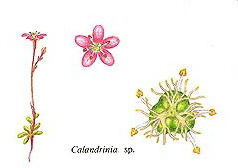Family: Montiaceae
Calandrinia
Citation:
Kunth, in Humboldt, Bonpland & Kunth, Nov. Gen. et Sp. Pl. 6, edn fol. 62, edn. qu. 77 (1823).
Derivation: After J.L. Calandrini, 1703-1758, a Genevan botanist.
Synonymy: Not Applicable Common name: Parakeelyas.
Description:
Succulent prostrate, procumbent, decumbent or erect annual or perennial herbs with a tap root, which may be thickened or tuberous.
Flowering stems prostrate or spreading to erect or ascending, usually leafy towards the base, 1-60 cm long; leaves basal and on the lower part of the flowering stems in most species, largest at the base of the plant and decreasing in size along the flowering stems, alternate or opposite, sessile or rarely petiolate, succulent, terete or flat or with concave upper surface, entire, acute to obtuse, glabrous; inflorescence a few- to many-flowered cyme; pedicels erect, spreading or reflexed in fruit; bracts alternate or opposite, usually scarious, rarely herbaceous; sepals persistent or deciduous; petals 4-11, often 5, free, white, pink or purple; stamens 3 to numerous; ovary superior, ovoid to globose, ovules 1 to numerous; stigmas 3 or 4, free to the base or on a short style.
Capsule dehiscing through 3 or 4 valves or rarely through a pore at the apex, light-brown or rarely black (C. granulifera); seeds 1 to numerous, smooth or variously patterned.

| Calandrinia sp. (bottom left).
|
Image source: pl. 9b/left in Jessop J.P. & Toelken H.R. (Ed.) 1986. Flora of South Australia (4th edn).
|
|
|
Distribution:
|
About 40 species native to Australia; a total of about 120 species in Australia and the Americas.
|
|
|
Biology:
No text
Key to Species:
|
1. Stigmas 4; capsules 4-valved |
|
|
|
2. Leaves alternate; petals 5-9 mm long; seeds ribbed, a dark red-brown to black |
|
C. ptychosperma 10. |
|
2. Leaves opposite; petals 3-5 mm long; seeds smooth to faintly colliculate, red-brown |
|
C. stagnensis 15. |
|
1. Stigmas 3; capsules 3-valved or with a terminal pore |
|
|
|
3. Capsule pear-shaped, opening by a terminal pore; seeds 2, superposed |
|
C. disperma 5. |
|
3. Capsule ovoid or globose or oblong-cylindrical, opening by valves; seeds usually more than 2, not superposed |
|
|
|
4. Stamens numerous (more than 20); basal leaves usually more than 5 cm long; petals more than 7 mm long |
|
|
|
5. Stigmas on a short style; petals more than 10 mm broad; seeds more than 1 mm long |
|
C. balonensis 1. |
|
5. Stigmas free to the base; petals up to 10 mm broad; seeds less than 0.8 mm in any direction |
|
|
|
6. Stems branching before giving rise to flowering stems; leaves in fascicles only; seeds reticulate |
|
C. reticulata 13. |
|
6. Stems giving rise to flowering stems before branching; leaves alternate and sometimes in fascicles; seeds smooth or colliculate |
|
|
|
7. Seeds orbicular and smooth |
|
C. remota 12. |
|
7. Seeds reniform and distinctly patterned (colliculate) |
|
C. polyandra 9. |
|
4. Stamens less than 20; basal leaves usually less than 5 cm long; petals usually less than 7 mm long |
|
|
|
8. Capsule black, subglobose, trigonous, usually less than 2 mm long; sepals deciduous |
|
C. granulifera 7. |
|
8. Capsule light-brown, ovoid to oblong-cylindrical or globose (not trigonous), more than or equal to 2 mm long; sepals persistent |
|
|
|
9. Leaves all radical, petiolate; capsule circumciss at the base, pericarp membranous |
|
C. pumila 11. |
|
9. Leaves basal and on flowering stems, sessile; capsule not circumciss, pericarp crustaceous |
|
|
|
10. Sepals more than or equal to 5 mm long; petals more than or equal to 7 mm long; capsule with acuminate recurved valves; seed flattened towards the margin |
|
C. menziesii 8. |
|
10. Sepals less than 5 mm long; petals less than 7 mm long; capsule with obtuse incurved or involute valves; seed not flattened towards the margin |
|
|
|
11. Stigmas on a short style; seeds 4-8; capsule oblong- cylindrical to clayate |
|
C. brevipedata 2. |
|
11. Stigmas free to the base; seeds less than 4 or more than 10; capsule ovoid |
|
|
|
12. Seeds less than 20, orbicular, smooth to faintly colliculate; petals less than 2 mm broad |
|
|
|
13. Bracts opposite; stamens 5-7; seeds 10-20, dark-brown to red-brown, 0.5-0.7 mm diam |
|
C. calyptrata 3. |
|
13. Bracts alternate; stamens 3-4; seeds 1-3, black, 0.7-1 mm diam |
|
C. corrigioloides 4. |
|
12. Seeds numerous (i.e. more than 20), reniform, colliculate to papillate; petals more than or equal to 2 mm broad |
|
|
|
14. Inflorescence twining; fruiting pedicel curved upwards; capsule more than 5 mm long; seeds without coppery lustre |
|
C. volubilis 16. |
|
14. Inflorescence straight (never twining); fruiting pedicel straight, reflexed; capsule less than 5 mm long; seeds with coppery lustre |
|
|
|
15. Basal leaves more than 1 cm long; pedicels 8-20 mm long |
|
C. eremaea 6. |
|
15. Basal leaves less than 1 cm long; pedicels 3-5 mm long |
|
C. sphaerophylla 14. |
Author:
Not yet available
|

